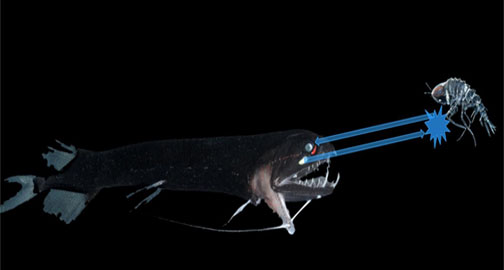
The dragonfish has light-producing organs to shine on and detect prey. The crustacean Cystisoma, has an antireflective brush structure on its legs that diffuses light, enabling it to hide in plain sight. [Image: Laura Bagge/Duke University]
In the deep ocean, where darkness is a constant, a momentary flash of light from a bioluminescent predator can reveal the location of reflective, tasty prey. Some nearly transparent sea creatures disguise themselves by covering themselves with two types of tiny nanostructures that drastically reduce the animals' ability to reflect light (Current Biology, doi:10.1016/j.cub.2016.09.033).
Built-in protection
Laura Bagge, a Duke University (USA) doctoral candidate in biology, discovered the nanosized surface structures by taking scanning electron micrographs of seven species of amphipods, an ocean-dwelling crustacean. The legs of the largest species examined, Cysistoma (a creature with a body length exceeding 100 mm), were covered with ordered arrays of protruberances roughly 200 nm high and spaced about 96 nm apart. In size and shape, the structures resembled those found on the transparent wings of some insects, as well as moths' eyes.
Under the scanning electron microscope, other amphipods, such as those from the genus Phronima, were found to be coated with monolayers of spheres of organic material, that ranged in diameter from 52 to 320 nm—which is still below the threshold of light visible to humans. These spheres may actually consist of coccoid bacteria, though it will take more research to confirm this.
Reflecting predators
Bagge and Duke biologist Sönke Johnsen also modeled the reflectance of the animals' cuticles, or chitinous exoskeletons, within the seawater environment. Since even 1 percent reflectance can light up free-swimming prey animals against the dark background of the ocean, minimizing reflections helps these species survive against predation.
The subwavelength protruberances modify the refractive-index gradient between the cuticles and the seawater. Bagge and Johnsen determined that both kinds of nanostructures on reduce the animals’ reflectance by as much as a hundredfold, from 1 percent to less than 0.1 percent, depending on wavelength and angle of incidence. According to the researchers, future studies should test these optical models against observations of light scattering off entire bodies of living organisms, not just deceased specimens preserved for micrography.
Zoologist Karen Osborn of the Smithsonian Institution's National Museum of Natural History (USA) contributed the amphipod specimens to the study.
